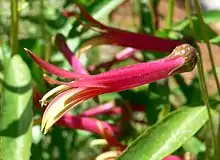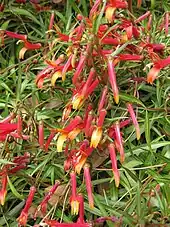Lobelia laxiflora
Lobelia laxiflora is a species of flowering plant in the family Campanulaceae. It is native to the Americas, where it is distributed in South, Central, and North America as far north as Arizona in the United States. It is known by several English-language common names, including Mexican lobelia, Sierra Madre lobelia, Mexican cardinalflower, looseflowers lobelia, and drooping lobelia.[1] In Spanish and Nahuatl it is known as aretitos, acaxóchitl, and chilpanxóchitl.[2] It has gained the Royal Horticultural Society's Award of Garden Merit as an ornamental.[3]
| Lobelia laxiflora | |
|---|---|
 | |
| Scientific classification | |
| Kingdom: | Plantae |
| Clade: | Tracheophytes |
| Clade: | Angiosperms |
| Clade: | Eudicots |
| Clade: | Asterids |
| Order: | Asterales |
| Family: | Campanulaceae |
| Genus: | Lobelia |
| Species: | L. laxiflora |
| Binomial name | |
| Lobelia laxiflora | |
In general, this is a perennial herb, subshrub, or shrub usually growing up to about 1.5 meters in maximum height, but known to reach 3 meters. The leaves vary in shape, size, and texture. The inflorescence is a raceme up to 40 centimeters long bearing leaflike bracts and several flowers. The flower may be over 6 centimeters long including its tubular base and corolla with narrow, spreading lobes. It is usually red, sometimes yellowish. The anthers protrude from the corolla. The plant produces seeds and also spreads via underground runners.[1]
In Mexico this plant grows in pine-oak forest habitat. In Arizona it has been noted in riparian woodland.[1]
The hummingbird flower mite (Tropicoseius chiriquensis) lives in the flowers of this plant, feeding on the nectar and pollen and laying eggs. Each flower blooms for about a week, enough time for the mite to complete its life cycle.[4]
Like other lobelias, this species contains medicinally useful alkaloids. Several new compounds have been discovered during chemical analyses of this plant.[5][6]

References
- Lobelia laxiflora. Plant Abstracts. Arizona Game and Fish Department.
- "Lobelia laxiflora". Germplasm Resources Information Network. Agricultural Research Service, United States Department of Agriculture. Retrieved 23 January 2018.
- "AGM Plants July 2021 © RHS – ORNAMENTAL" (PDF). The Royal Horticultural Society. Retrieved 21 December 2021.
- Velázquez, T. and J. F. Ornelas. (2010). Effects of pollen in Lobelia laxiflora (Lobeliaceae) long-lived flowers on fecundity of Tropicoseius chiriquensis (Acari: Mesostigmata: Ascidae). Annals of the Entomological Society of America 103(3) 397-403.
- Rahman, E. H. A. and A. R. A. Monem. (2014). Cholinesterase inhibiting activity and a new piperidine alkaloid from Lobelia laxiflora L. roots (Campanulaceae). Rec Nat Prod 8(2) 199-202.
- Philipov, S., et al. (1998). Phytochemical study and antiinflammatory properties of Lobelia laxiflora L. Z Naturforsch C 53(5-6) 311-17.
External links
- Lobelia laxiflora. USDA NRCS Plants Profile
- Lobelia laxiflora. NatureServe Explorer
